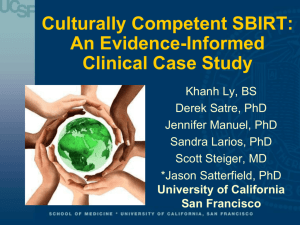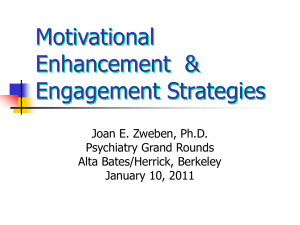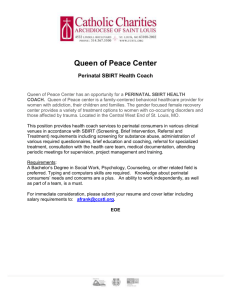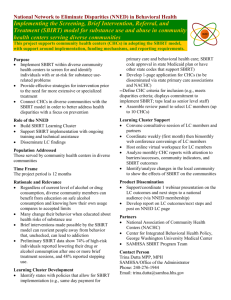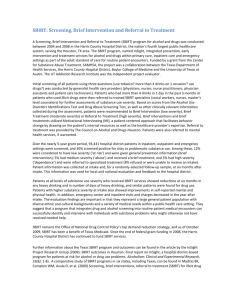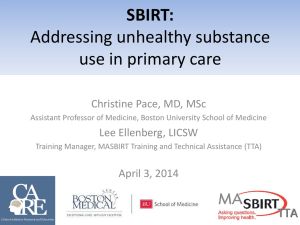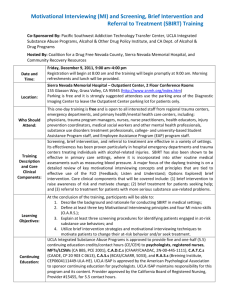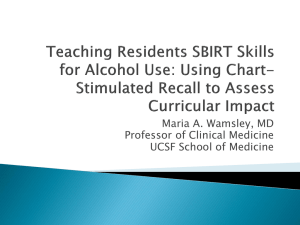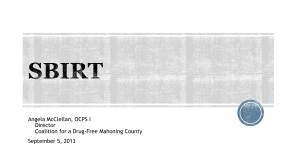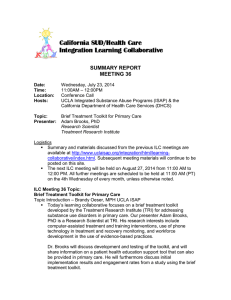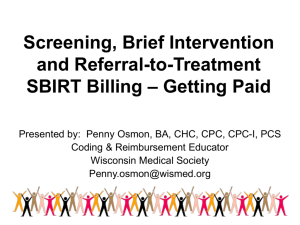(1) Understanding Addiction & SBIRT
advertisement
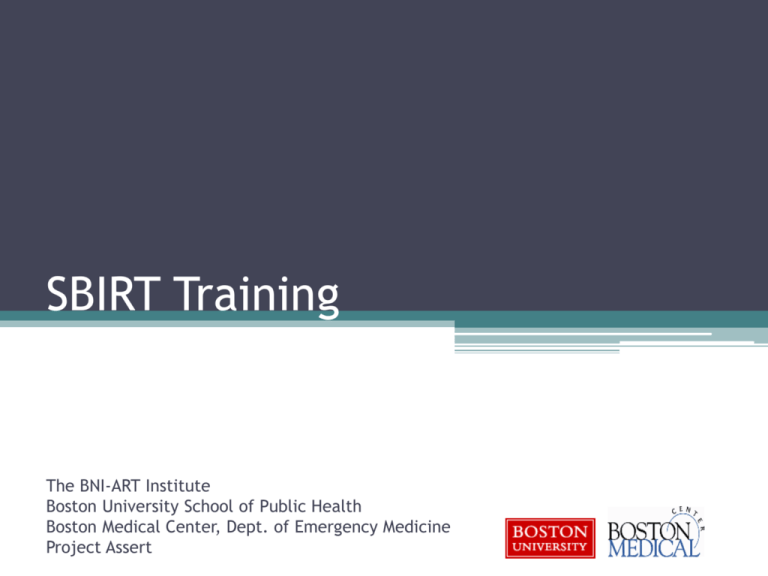
SBIRT Training The BNI-ART Institute Boston University School of Public Health Boston Medical Center, Dept. of Emergency Medicine Project Assert BMC Emergency Department’s Health Promotion Advocates : • provide comprehensive care & prevention • focus on substance abuse in context of other health and safety issues • offer info & health resources with emotional support & advocacy; • collaborates with staff to serve 5,000 + pts/yr Funded in 1993 SAMHSA/CSAT; 1998 line item in BMC ED Budget; a model for SBIRT in 2003 Lead HPA: Ludy Young., HPAs: John Cromwell, Dan Heenen, Brent Stevenson,, & Moses Williams Adm Dir, Emma Riley; Med Dir., Dr. Edward Bernstein, What is SBIRT? • SBIRT is a comprehensive, integrated public health approach to the delivery of early intervention and treatment services to persons with at-risk and substance use disorders • The primary goal of SBIRT is to identify and effectively intervene with those who are high risk for psycho-social or health care problems related to their substance use. • Primary care centers, hospitals, EDs and other community settings provide excellent opportunity for early intervention The S-BI-RT • Screening to identify patients with high-risk or dependent drinking and drug use • Brief Intervention: Conversation to motivate patients who screen positive to consider healthier decisions (e.g. cutting back, quitting, or seeking further assessment) • Referral to Treatment: Actively link patients to resources when needed Outline • Why people use alcohol and drugs • Different frameworks for viewing substance use ▫ ▫ ▫ ▫ Moral failing Biomedical model Public health model How SBIRT fits in • Evidence for SBIRT • Logistics of SBIRT in health care settings Why do people use alcohol & drugs? • Feels good/ not feel bad • Socialize, hang out • Feel outgoing, less shy • Have fun, relax • Celebrate • Stay alert • Tastes good Why do people use alcohol & drugs? • Environmental norms • Work place • Family, home • Friends • Peer pressure Why do people use alcohol & drugs? • Cope with stress • Self-medicate • Response to life trauma • ACEs: Adverse Childhood Events • Emotional, physical, sexual abuse; neglect; household dysfunction How does society view… …Alcohol and drug use / users? • In the past? • Currently? • In your community? A Moral Failing • • • • • • • • • Character flaw Sign of personal weakness Lacks values, strength Menace, danger to society Lazy, not contributing to society Drugs are bad, deviant, criminal Alcohol is acceptable up to a certain point To be avoided; “Just say no” Chose wrong path Traditional Approaches • War on Drugs, Just Say No • Jail, prison, department of corrections • Shame and blame confrontation • Treat and street in medical encounter • Stigmatization Dr. Nora Volkow: NIDA Director “STIGMA” In years past, science discovered the causes of epilepsy and leprosy and helped free the afflicted of stigma. “We are witnessing another instance of one of the great moral achievements of science: establishing the right of people who have been regarded as hopeless or untouchable to full consideration as human beings.” Addiction Science & Clinical Practice 2007; 4:1 Reward and Craving Pathways Drugs can be “Imposters” of Brain Messages Cocaine increases dopamine levels by blocking re-uptake into cells dopamine Natural Rewards Elevate Dopamine Levels DA Concentration (% Baseline) Food % of Basal DA Output 200 NAc shell 150 100 50 Empty Box Feeding 0 0 60 120 Time (min) 180 Sex 200 150 100 Sample 1 Number Female Present 2 3 4 5 6 Di Chiara et al., Neuroscience, 1999.,Fiorino and Phillips, J. Neuroscience, 7 8 Functionally… Dopamine D2 Receptors are Decreased by Addiction Cocaine Meth Alcohol Heroin Control Addicted Dopamine is only part of the story • Scientific research has shown that other neurotransmitter systems are also affected: ▫ Serotonin Regulates mood, sleep, etc. ▫ Glutamate Regulates learning and memory, etc. Genetic, Developmental and Environmental Interaction Addicted sibling Striatum Non addicted sibling Non addicted unrelated Precuneus Amygdal Orbitofrontal a cortex Risk factors Risk factors Risk factors Protective factors Protective factors Protective factors Stop impulse response Stop impulse response Stop impulse response Volkow ND, Baler RD. Science 2012; 335:546. Ability to stop an impulse to act is determined by the overall balance of risk factors and protective factors • Maladaptive risk factors ▫ ▫ ▫ ▫ high impulsivity, stress reactivity novelty seeking, conditioning/habits negative emotionality poor reality awareness • Adaptive protective factors ▫ positive emotionality ▫ robust inhibitory control and executive function ▫ strong coping skills and good frustration management temper cues for potential reward SAMHSA CSAT Jack B. Stein, MSW, PhD Drug overdose deaths were second only to motor vehicle crash deaths among leading causes of unintentional injury death in 2007 in the United States. (27,658) Addiction similar to other Chronic Illnesses • <30% of patients adhere to prescribed medications & diet or behavioral changes • 50% recurrence rate • Substance abuse should be insured, monitored, treated and evaluated like other chronic diseases Hypertension Diabetes Asthma Addiction Paradigm Shift = Innovative Approaches Shift from moral failing to addiction as a chronic and recurrent condition: • Chronic disease management • Integration with behavioral health • Expanding treatment options ▫ Medication assistance : suboxone, methadone, naltrexate ▫ Intensive outpatient services ▫ Sober housing ▫ Drug court and treatment in prison Treatment success depends on: A comprehensive model that considers • Interpersonal relationships • Employment options • Housing options • Mental health services • Safety and support • Human rights, dignity …and more Learning from Successful Examples: The Cardiac Care Chain of Survival ? Saving lives & promoting recovery, cardiac & addiction require: • community involvement, screening and access • structural changes informed by evidence • $ and monitoring of access & quality • workforce development • an integrated, coordinated, collaborative system • public education, and advocacy & de-stigmatization Biomedical Model Isn’t Enough • Chronic illness model doesn’t take high-risk use into account o o Many people who use alcohol and drugs do not meet criteria for dependence Intervention still needed for preventing future injury, illness, or possible dependence • Substance use doesn’t happen in a vacuum o o cost society over $600 billion annually have far-reaching implications for family, workplace, community, and health care system SBIRT Addresses Both • Continuum of Use o o o Low-risk use High-risk / unhealthy use Abuse and dependence (substance use disorders) • Continuum of Care Brief intervention, action plan o Wrap-around services o Detox, treatment types o SBIRT: Part of a Public Health Solution • It attempts to identify those who are high-risk for psycho-social or health care problems related to their substance use • It attempts to effectively intervene in a nonjudgmental, empathic, and motivational way • It offers an opportunity for finding and connecting to additional services • It’s a holistic way of addressing the many ways the individual affects and is affected by its environment/society Does SBIRT work? Evidence Research Demonstrates Effectiveness • A growing body of evidence about SBIRT’s effectiveness, including cost-effectiveness, has demonstrated its positive outcomes. • The research shows that SBIRT is an effective way to reduce alcohol and drug related health and social/ legal problems. Making a Measurable Difference • Since 2003, SAMHSA has supported SBIRT programs with over 1.5 million persons screened. • Outcome data confirm a 40% reduction in harmful use of alcohol by those drinking at risky levels and a 55% reduction in negative social consequences. • Outcome data also demonstrate positive benefits for reduced illicit substance use. Based on review of SBIRT GPRA data (2003-2011). Brief Intervention in the Clinical Setting Reduces Cocaine and Heroin Use Testing the ASSERT Model- Randomized Control Trial in Heroin-Cocaine Users • Intervention group more likely to be abstinent at 6 months (n=778 + hair at baseline) follow-up rate 82% cocaine alone (22.3% vs 16.9%) heroin alone (40.2% vs 30.6%) both drugs (17.4% v s 12.8%) adjusted OR of 1.51-1.57 • Cocaine levels in hair reduced 29% intervention group vs 4% control group Bernstein et al. Drug & Alcohol Dependence, 2005;77:49-59 Academic Emergency Medicine SBIRT Collaborative New England Med. Boston Medical Univ. of Michigan. Rhode Island Hospital Yale Univ. Denver Health Medical Cooper Health Univ. of Southern California Univ. of Virginia Charles Drew Univ. Univ. of California Univ. of New Mexico Howard Univ. Emory University 26% screened positive for at risk drinking Patient Response to SBIRT at 3 month F/U Summary (n=1173) At 3 months, controlling for baseline drinking levels, patients receiving the intervention • 2x as likely to drink within the NIAAA low risk guidelines as the controls (39% vs. 19%). • had 3 fewer ‘typical number of drinks per week’ than controls • providers reported greater utilization of SBIRT in their practice Meta-analyses of BI and MI Alcohol only ▫ Kaner et al. (Cochrane), 2007 I vs C ↓4 drinks/wk ▫ Vasilaki et al, 2006 aggregate .18, .60 at 3 months ▫ USPSTF, 2004 69% vs. 57% drinking risky amts; 38 grams/wk • Alcohol/drugs ▫ Dunn et al, 2001 ▫ Hettema et al, 2005 (.30 at 1 yr) A Ten Minute Brief Negotiated Interview By Practitioners Reduces Hazardous and Harmful Drinking Among ED Patients ( Donofrio et al. Ann of Emerg Med. 2012) N=889 Mean # drinks/ past 7 days • • BNI BL 19.8 SC BL 20.9 12 mo 14.3 12 mo 17.6 # Binge drinking days/past 28 • • BNI BL SC BL 7.5 7.2 12 mo 12 mo 4.7 5.8 Driving after >3 drinks • • BNI BL SC BL 38% 43% 12 mo 12 mo 29% 42% Recognizing the treatment gap and the need for prevention with a nationwide movement to a standard of care • US Preventive Services Task Force • Level I and II Trauma Centers • Millions in federal SBIRT funding for state & residency training programs • NIH funding • Joint Commission hospital SBIRT standards • reimbursement codes - Centers for Medicare & Medicaid Services; the AMA (CPT codes) and E&M codes What does SBIRT look like? Screening Brief Intervention Referral to Treatment Screening What • NIAAA Qs, NIDA Qs, DAST, AUDIT-C, AUDIT, CRAFFT , ASSIST, Health Needs History When • Triage, while patient awaits medical attention Who • Health promotion advocate (HPA), health educator, medical assistant, triage nurse, social worker, doctor Where • Triage, bedside, waiting room, private room/office Brief Intervention = the BNI What • BNI = Brief Negotiated Interview (5-steps) When • Patient screens positive for risky alcohol/drug use Who • Health promotion advocate (HPA), health educator, nurse, doctor, social worker, medical assistant Where • Bedside, private room/office 5 Steps of the BNI 1. Build rapport ▫ Bringing up the topic, being nonjudgmental 2. Pros & Cons ▫ Ask what is liked/disliked about the behavior 3. Information & Feedback ▫ Give facts and feedback about the behavior, ask for thoughts 4. Readiness Ruler ▫ Assess readiness to make any changes (to be healthier, safer) 5. Prescription for Change ▫ Ask for action steps, create a plan together Referral to Treatment (or other services) What • Calling service providers, getting medical clearance (for detox), calling about insurance, arranging transportation, giving information: handouts, brochures, contact info., safety supplies When • Patient wants (and is good match for) additional services Who • Health promotion advocate (HPA), health educator, social worker, nurse, doctor, medical assistant Where • Bedside, private room/office Next, we'll break it down...
